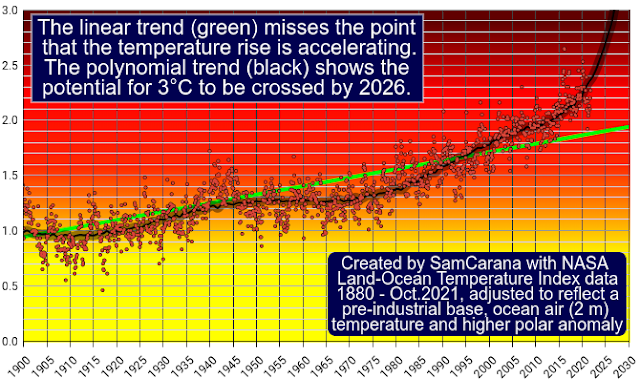Since the onset of the Industrial age global emissions of carbon have reached
near-600 billion tonnes of carbon (>2100 billion tonnes CO₂) at a rate faster than during the
demise of dinosaurs. According to research published in
Nature Geoscience, CO₂ is being added to the atmosphere
at least ten times faster than during a major warming event about 55 million years ago.
Australia, possessing an abundance of
natural gas, namely methane resources, is on track to become the world's
largest exporter. Leaks from hydraulic fracturing (fracking) production wells, transport and residues of
combustion are bound to
contribute significantly to atmospheric methane. However, despite economic objections, not to mention accelerating global warming, natural gas from coal seam gas, liquefied to -161°C, is
favored by the government for domestic use as well as exported around the world.
In the Hunter Valley, NSW, release of methane from open-cut coal mining reached
above 3000 ppb. In the US methane released in some coal seam gas fields constitutes between 2 and 17 per cent of the emissions.
While natural gas typically emits between 50 and 60 percent less CO₂ than coal when burned, the drilling and extraction of natural gas from wells, fugitive emissions, leaks from transportation in pipelines result in enrichment of the atmosphere in methane, the main component of natural gas, 34 times stronger than
CO₂ at trapping heat over a 100-year period and 86 times stronger over 20 years. So, while natural gas when burned emits less CO₂ than coal, that doesn’t mean that it’s clean – the reason summed up in one word: methane.
Global warming triggered by the massive release of CO₂ may be catastrophic, but release of CH₄ from methane hydrates may be apocalyptic. According to
Brand et al. (2016), the release of methane from permafrost and shelf sediment has constituted the
ultimate source and cause for the dramatic life-changing global warming. The mass extinction at the end of the Permian 251 million years ago, when 96 percent of species was lost, holds an important lesson for humanity regarding greenhouse gas emissions, global warming, and the
life support system of the planet (
Brand et al. 2016, Methane Hydrate: Killer cause of Earth's greatest mass extinction).
The pledge for zero-emissions by 2050 is
questioned as governments continue to
subsidize, mine and export hydrocarbons. Examples include Saudi-Arabia, the Gulf States, Russia, Norway and Australia. A mostly compliant media highlights a zero-emission pledge, but is reluctant to report the scale of
exported emissions as well as the ultimate consequences of the open-ended rise of global temperatures.
Norway, a country committed to
domestic clean energy, is conducting large scale drilling for Atlantic and
Arctic oil. Australia, the fourth-largest producer of coal, with 6.9% of global production, is the
biggest net exporter, with 32% of global exports in 2016.
23 new coal projects are proposed n the Hunter Valley, NSW, with a production capacity equivalent to 15 Adani-sized mines.
Australian electricity generation is dominated by fossil fuel and about
17% renewable energy. Fossil fuel subsidies hit
$10.3 billion in 2020-21, about twice the investment in
solar energy in 2019-2020. State Governments spent
$1.2 billion subsidizing exploration, refurbishing coal ports, railways and power stations and funding “clean coal” research, ignoring the pledge for “
zero emissions by 2050”.
The pledge overlooks the global amplifying effects of cumulative greenhouse gases. At the current rate of emissions, atmospheric CO₂ levels would be near 500 ppm CO₂ by 2050, generating warming of the oceans (expelling CO₂), decreased albedo due to melting of ice, release of methane, desiccated vegetation and extensive fires.
Claims of “clean coal”, “clean gas” and “clean hydrogen” ignore the contribution of these methods to the rise in
greenhouse gases. Coal seam gas has become an additional
source of methane which has an
80 times more powerful greenhouse effect than CO₂. This adds to the methane leaked from Arctic permafrost, with atmospheric methane rising from ~ 600 parts per billion early last century to
higher than 2000 ppb. In the Hunter Valley, NSW, release of methane from open-cut coal mining reached
above 3000 ppb. In the US, methane released in some coal seam gas fields constitutes between
2 and 17 per cent of the emissions.
The critical index of global warming, rarely mentioned by politicians or the media, is the atmospheric concentration of CO₂. During 2020-2021 CO₂ rose from 416.45 to 419.05 parts per million at a rate of
2.6 ppm/year, a trend
unprecedented in the geological record of the last 55 million years. The combined effects of greenhouse gases such as cabon dioxide (CO₂), methane (CH₄) and nitrous oxide (N₂O) have reached near ~
500 ppm CO2-equivalent.













































